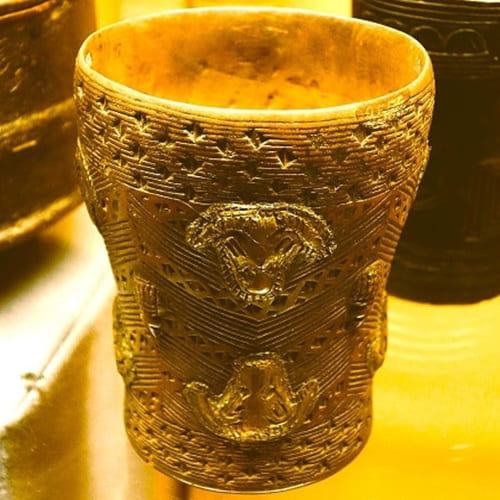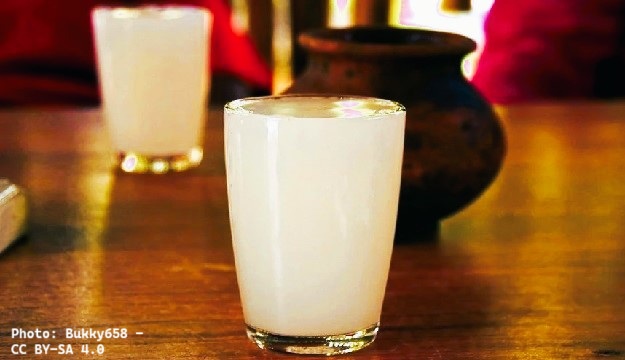Life Amid the Palms

September 2023 Welcome!

Toddy Palm Liquor
Come wine with us! Well, what we mean is: let's find out about the wine products produced from palm trees.
Did you know there are multiple palm species that produce wine? The common name for some palms even includes "wine" in them.
Some producers make a point of publicizing palm wine's benefits. Which we'll review soon, below.
 Is It Wine Time?
Is It Wine Time?Palmyra Palm Wine
The Palmyra Palm (Borassus flabellifer) is sourced to make Palm Wine Toddies. Especially throughout South & Southeast Asia. The flower stalks, called inflorescences are tapped to access the palm's sap. It first drains clear. Then it quickly changes to that white milky look.
THE PROCESS TO RETRIEVE SAP TO MAKE TODDY PALM LIQUOR
 Wouldn't It Be Nice to Drink Palm Wine
Wouldn't It Be Nice to Drink Palm WineIn such a Glass?
Buriti Palm Wine
The Moriche Palm (Mauritia flexuosa) is another palm useful for making Palm Tree Wine. It's native to Amazon forest rivers & swamps. Where the common name is often Buriti.
Every part of this palm is used for some locally valued product.
There are two ways people can produce Buriti Palm Wine.
- Dark red fruits are covered by a scale crust. All ripening between December on through early spring.
- To get to the fleshy yellow meat, it's boiled to loosen the scaly covering. Then workers retrieve the pulp much more easily.
- They then ferment the pulpy marrow to make Palm Wine.
The branching inflorescences are tapped for the sap. Inflorescences produce flowers which then make the valued Palm Tree Fruit.
The many inflorescence branches offer the chance to use fruit. Or make the cut to tap the sap.
Toddy Palm Liquor From the Cherry Palm
The Buccaneer Palm (Pseudophoenix vinifera) is also called Cherry Palm or Wine Palm. Native to the Caribbean, it had been heavily used to make Toddy Palm Liquor.
That practice decreased its numbers to near extinction. Now seldom used for that wine-making purpose.
The palm's life itself was threatened by the wine process.
- The palm was cut down to access the pith. That's located through the center of the palm trunk. It's soft flesh ripped out. Then squeezed to collect sweet sap. Workers fermented it to make Palm Wine.
- Note the epithet "vinifera." Which comes from the Latin word meaning "wine-bearing."
The Chilean Wine Palm
Chilean Wine Palm (Jubaea chilensis) used to be sourced for toddy palm liquor. Here's another where that process to access its sap almost brought it to extinction. Because the palm was cut down. Now it's protected in Chile's National Sanctuaries. Still considered a threatened species.
But it's now being cultivated in areas as diverse as Germany, England and California (US). It does well in a Mediterranean type of climate.
Will You Try Palm Wine?
Even if for its Benefits?
Life is certainly wine-derful when you look at the benefits palm wine brings! With 4 ounces of palm wine you consume 34 calories, or 143 kilojoules. Plus 0.4g protein, 2.5g carbs & 0.1g fat.
The benefits of palm wine can be healthy. For sure!
Particularly because of antioxidant & probiotic properties. It's high in magnesium & phosphorus. And has moderate amounts of calcium, copper, zinc, manganese, iron & sodium. And Vitamin C, with natural phenols.
 Wine Palm Offers its Product - Will You Have a Taste?
Wine Palm Offers its Product - Will You Have a Taste?But there are some drawbacks, too:
- It is an alcoholic drink. Though its alcohol content isn't way high, overconsumption could be problematic. Also because of the sugar. The sap & fruit make popular non-alcoholic drinks, too.
- There are some health-conscious producers. Yet in many places, it's not overseen for cleanliness. Neither for prevention of contaminants.
- Many studies related to palm wine properties have been published. To find that its benefits are useful for rats! Very few involve humans.
You might find it sold near you. Or maybe not! It's not commonly sold throughout the U.S. But is available in Pennsylvania, Colorado & California. Plus in some U.S. Southeastern states. Do you know of others?
So if you want to give it a try, remember It's 5 O'clock Somewhere! (RIP Jimmy Buffett)
Til Next Time,
Karen & Bill of Mission: Palm Trees

P.S. Don't miss Our Latest Articles. And if you want to see what we have for you, available by subject be sure to check out our Mission: Palm Trees Site Index
P.P.S. Have you missed any of our Life Amid the Palms memos? Easily Check our past year's issues, by subject & date, of Life Amid the Palms Here>






